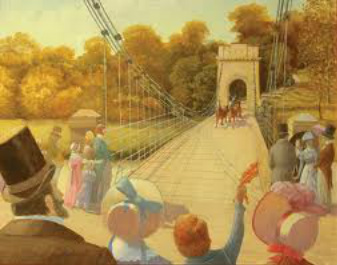|
When you read an entry on a family tree of a family member drowning whilst crossing the River Whiteadder in the Scottish Borders, on the night of the 31st December 1822 - the mind is automatically drawn to the legendary Hogmanay revelries synonymous with this part of the world. But was this actually the case?
The Edinburgh Advertiser reported in January 1823 the following:- "MELANCHOLY ACCIDENT - On the forenoon of Tuesday se'nnight Mr. Aaron Young of Loanend, in the parish of Norham, farmer, and his servant Elliot, a lad about 17 years of age, were unfortunately drowned in the Whiteadder at Bluestone-ford. Mr Young, his wife and Miss Bell his niece, were returning from a visit at Fairlaw, and having come to the ford, the ladies were alarmed at its appearance, and resolved to go up to Allanton and cross by the boat, giving directions to the servant to meet them on the other side with the cart. Off they set accordingly, and Mr Young, who was on horseback, and the lad, ventured into the ford, which was gorged with ice, and which being put in motion by the horses and the cart, came down in such quantities, and with such force, as to upset them all. The body of Mr Young was picked up soon after near Edington Mill, but that of the servant was not found until next day. The horse Mr Young rode escaped, but the one in the cart was drowned." Was this a case of the 19th Century equivalent of drinking and driving, or was it as the paper reports a "Melancholy Accident" ? Whatever the case at least the ladies -having the benefit of female intuition - survived! A couple of links showing the River Whiteadder at Bluestone Ford in very different moods! http://www.youtube.com/watch?v=sbFce2tv8UU http://www.geograph.org.uk/photo/162974 http://www.flickr.com/photos/30993740@N06/5238627064/lightbox/ Since writing the above I started wondering to myself what alternatives would have been available to the unfortunate gentleman to cross the River Whiteadder with a horse and cart in 1822? I can find alternative crossings of the Tweed, the closest being the bridge at Twizell, crossed by The Lord Howard and his army at 11.00 am on the morning of 9th September 1513 on his way the infamous battle against the Scots at Flodden Field. However, I am struggling to find an alternative crossing of the River Whiteadder that would not have involved a serious and lengthy detour. Looking at a map and the most obvious route from Fairlaw to Loanend - Mr Young was no doubt heading to cross the Tweed at the recently opened (1820) Union Chain Bridge at Horncliffe, which would have taken him virtually to his front door and been by far the quickest route home.
3 Comments
|
AuthorSusie Douglas Archives
August 2022
Categories |
Copyright © 2013 Borders Ancestry
Borders Ancestry is registered with the Information Commissioner's Office No ZA226102 https://ico.org.uk. Read our Privacy Policy


